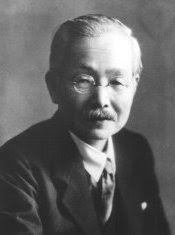 For centuries it was believed that the tongue only perceived four basic tastes: sweet, sour, salty, bitter. That was until the early 1900s when Professor Kikunae Ikeda (right) of
For centuries it was believed that the tongue only perceived four basic tastes: sweet, sour, salty, bitter. That was until the early 1900s when Professor Kikunae Ikeda (right) of ‘Plant Scents’ [American Scientist (Vol 92 No 6 Nov-Dec 2004 p.514).
More details in: Susan McLaughlin and Robert F. Margolskee,
‘The Sense of Taste’ [American Scientist (Vol 82, No.6 Nov-Dec 1994 p.538)].
See also: www.glutamate.org/media

[Left]: Human taste buds (SEM at 2,800X). This tongue is covered not by protruding papillae, but by soft, overlapping sheetlike cells, each with its own intricate surface pattern which is doubtless as distinctive as a fingerprint. (Source: Cornell University)
'The word ‘umami' is now widely recognized and used amongst chefs, food writers and food fans around the world, but not so long ago it was known only in Japan, or among scientists, and even then viewed with considerable skepticism. One man who has been aware of umami longer and understands it better than most is Professor Tim Jacob, School of Biosciences, University of Cardiff who specializes in the relationship between smell and taste.
“Umami has only been accepted in the west for the past 10 years or so, and the discovery of taste receptors for umami gave it credibility,” says Jacob.
'Another area for further study that relates to this is the position of taste buds and receptors in the mouth. Many people may be familiar with diagrams of the human tongue, neatly divided into areas that respond to different basic tastes, such as the sweet area, and the bitter area.
'Although it was thought for many years that this was how the taste buds worked, this theory was subsequently disproved, partly due to the emergence of umami, and scientists began to agree that all tastes could be experienced all over the tongue. But again, Jacob suggests that this is not the whole story either. In fact, “certain regions are more sensitive to one or two tastes [so] it’s a case of throwing the baby out with the bathwater, to throw out the idea that there are sensors [for certain tastes] in certain areas.”
In fact, taste buds are not simply located on the tongue, but also on the palate, esophagus and throughout the oral cavity. Jacob is particularly keen to point out that there is a high density of umami taste buds on the palate in addition to those on the tongue, and what is more, these are connected to the brain by the facial nerve, which is separate to the nerves serving the tongue. Thus, he says, “umami has its own direct link to the brain.”
Jacob, however, gives a more fundamental explanation of the importance of umami as a taste, which touches on the basic role of taste in the way we eat. “The purpose of taste,” he says, “is to drive appetite … umami is the taste of proteins and amino acids, so it makes perfect sense that we have to have the umami taste.”

[Left]: Tongue with bitter, sweet and umami receptors in green and sour receptors in red. Credit: Nicholas Ryba, NIDCR and Charles Zuker, UCSD
August 23, 2006
UCSD-led Team Discovers How We Detect Sour Taste
By Sherry Seethaler
A team headed by biologists from the University of California, San Diego has discovered the cells and the protein that enable us to detect sour, one of the five basic tastes.
The study reports that each of the five basic tastes is detected by distinct taste receptors—proteins that detect taste molecules—in distinct cells. The team previously discovered the sweet, bitter and umami (savory) receptors and showed that they are found in separate cells, but some researchers have argued that sour and salty tastes, which depend on the detection of ions, would not be wired in the same way.
“Our results show that each of the five basic taste qualities is exquisitely segregated into different taste cells” explained Charles Zuker, a professor of biology at UCSD and a Howard Hughes Medical Institute Investigator, who headed the study. “Taken together, our work has also shown that all taste qualities are found in all areas of the tongue, in contrast with the popular view that different tastes map to different areas of the tongue.”
No comments:
Post a Comment